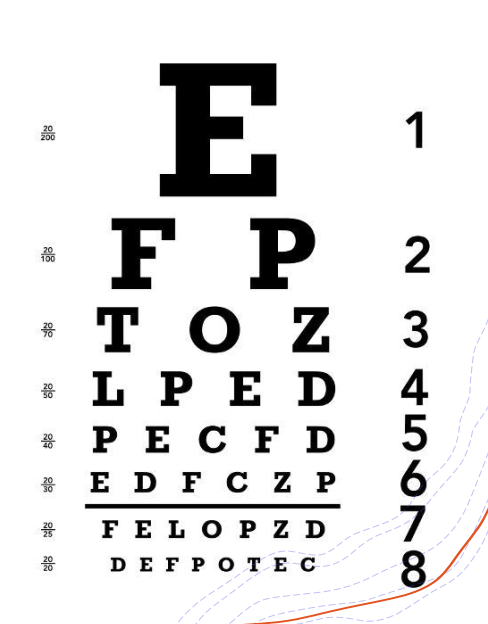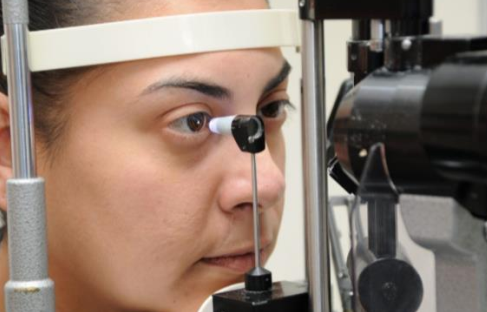-
What diagnostic tests consists of letters and numbers that progressively get smaller to measure visual acuity?

The Snellen chart
-

What does a tonometry assess?
The eye's intraocular pressure by checking the resistance of the cornea. This can be used to check for conditions like glaucoma.
-
What is myopia?
Near-sightedness, caused by having the eye too long and makes it hard to see things far away.
-
What is hyperopia?
Far-sightedness from a short eyeball. Where the image is focused behind the retina which causes a hard time seeing objects up close.
-
What is presbyopia?
Far-sightedness associated with aging. The loss of elasticity reduces accommodation.
-
What is accommodation?
The ability of the eye to focus on the image; making it sharper.
-
What is the difference between pinkeye and conjunctivitis?
Conjunctivitis: a superficial inflammation or infection involving primarily the conjunctiva.
Pinkeye: an infection of the sclera and eyelid.
-

What eye infection is being shown in the picture?
A stye - involves a hair follicle on the eyelid; usually a staph infection.
-
What is keratitis and some of its risks?
It's an inflammation of the cornea, usually caused by an infection. There's an increased risk of ulceration and scarring which can interfere with vision.
-
What does the Canal of Schlemm do?
It collects aqueous humour from the anterior chamber and delivers it to the veins of the eyeball.
-
What is aqueous humour?
Fluid produced from the ciliary body which flows into the anterior chamber.
-
What does the trabecular meshwork do?
Located at the base of the cornea; is responsible for draining the aqueous humor.
-
What causes glaucoma?
Due to increased intraocular pressure from excessive accumulation of aqueous humour.
-
What is the difference acute/narrow-angled and chronic/wide-angled glaucoma?
Acute: where the angle between the cornea and iris is decreased (there's an enlargement of the lens), this ends up blocking/slowing the flow of aqueous humour in the anterior chamber, increasing intraocular humour.
Chronic: mostly happens in older people. Where the canal of Schlemm becomes obstructed and the outflow of aqueous fluid is diminished. Leads to ischemia and damages to the retinal cells. Damage is irreversible and will lead to blindness.
-
When does chronic glaucoma typically develop?
In older people - usually beginning at age 50.
-
What are some symptoms of chronic glaucoma?
- increased intraocular pressure
- corneal edema
- altered light refraction = blurred vision
- appearance of "halos" around light
- eye discomfort
-
Acute glaucoma may be caused by ___.
development abnormality, aging or scar tissue.
-
What are some signs and symptoms of acute glaucoma?
- pain and nausea
- headache
- blurred vision
- bulging cornea
- pupil unresponsive to light
-
How can somebody treat chronic glaucoma?
- eye drops to reduce aqueous humour
- drugs to reduce intraocular pressure
- trabeculoplasty/trabeculectomy if unresponsive to increase drainage
-
How can somebody treat acute glaucoma?
- surgery to open the Canal of Schlemm
- laser iridectomy
-
What is a cataract?
When the lens becomes cloudy and thus interferes with the transmission of light. Cloudiness is caused by the build up of proteins in the lens. This may be caused by degeneration related to aging or metabolic abnormalities.
-
What are the different types of cataracts?
Congenital: usually a result of maternal infection such as rubella or toxoplasmosis.
Traumatic: due to a blow to the eye.
Age related: from as you get older.
Secondary: due to a disease such as diabetes.
-
What is the only indicator that you may have cataracts?
Your blurred vision progresses over your entire field of vision and becomes darker over time.
-
If a cataract is severe enough, what intervention can be done?
The damaged lens can be removed and replaced by an artificial one. A peripheral iridectomy may be included to prevent postoperative glaucoma.
-

What type of eye condition is this picture showing?
A cataract.
-
The retina contains two type of photoreceptors, what are they?
Rods - motion, black-and-white vision
Cones - colour, central vision
-
Where are cones located?
In the macula.
-
What area of the eye is responsible for maximum visual acuity and colour vision?
The fovea, containing only cones and is at the very center of the macula.
-
How does a detached retina occur?
It's an acute problem that may occur due myopia, degeneration with aging or scar tissue.
-
A person with a detached retina may see what?
- area of black
- floaters that won't go away
- a blind spot called a "dark curtain"
-
What are some interventions to treat a detached retina?
Scleral buckling, laser therapy to close holes and reattach the retina
-
What is macular degeneration?
Where the macula and fovea centrals (responsible for central vision) degenerate and thus our central vision becomes blurred and eventually lost.
-
What are the two types of hearing loss?
Conduction deafness: when sound is blocked in the external or middle ear. Usually from obstruction of wax or foreign object in ear canal. Possibly scar tissue or adhesions.
Sensorineural deafness: due to damage to the organ of Corti or the auditory nerve. Can be from infection, ototoxic drugs, head trauma, congenital deafness, sudden loud noise or prolonged exposure to it.
-
Hearing aids ___.
amplify sound and improve hearing capacity.
-
Sesorineural loss can be treated with ___ in very young, congenitally deaf people.
cochlear implants
-
Otitis media is an infection of the ___.
middle ear cavity.
-

What is this describing?
Otitis media
-
How can otitis media be treated?
- pain meds first
- antibiotics if symptoms don't subside
- decongestants
- tympanoplasty if damage is done
-
What is cholesteatoma?
A cyst like mass (which may develop from chronic otitis media).
-
Describe the effects of cholesteatoma?
A mass is formed in the middle of the ear cavity. This eventually erodes the ossicles and surrounding bone leading to hearing impairment. May effect hearing, balance and the function of facial muscles.
-

What is this describing?
Otitis externa
-
What is otosclerosis?
An imbalance of bone formation and resorption. Conduction of sound into the cochlea is blocked.

